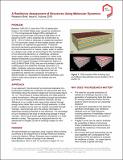Research Brief: A Resilience Assessment of Structures Using Molecular Dynamics
Author(s)
Keremidis, Kostas; Abdolhosseini Qomi, Mohammad Javad; Pellenq, Roland; Ulm, Franz-Josef
Download2018Vol6_MDResilience_Keremidis_FINAL.pdf (618.3Kb)
Metadata
Show full item recordAbstract
Between 1993-ˇ2012, more than 75% of catastrophic losses in the United States were caused by windstorms
(1). The Congressional Budget Office estimated an average annual damage amounting to $28 billion (0.16 percent of GDP), with a potential rise to $38 billion by 2075 – 55% of which is attributed to coastal development
(2). This economic impact of wind related events calls for reevaluation of engineering approaches. Traditional structural mechanics approaches evaluate wind damage of structural elements (i.e. beams, plates, walls) in relation to a design code, while not accounting for the contribution of non-ˇstructural elements (i.e. sheathings, windows)
which clearly reflect on building integrity (3). While more detailed frameworks accounting for all elements do exist, such as the Federal Emergency Management Agency’s HAZUS-ˇMH (FEMA 2016), they are only limited to specific building types and qualitative damage description (i.e. slight, moderate, extensive damage, and so on) (4). This motivates the development of an approach that can quantitatively address the complexity of buildings in element scale (i.e. structural/non-ˇstructural elements), and system scale (accounting for any building use and geometry).
Date issued
2018-06Series/Report no.
MIT CSHub Research Brief; Volume 2018, Issue 6
Keywords
Resilience, Structural Mechanics, Structural Engineering, Climate Change